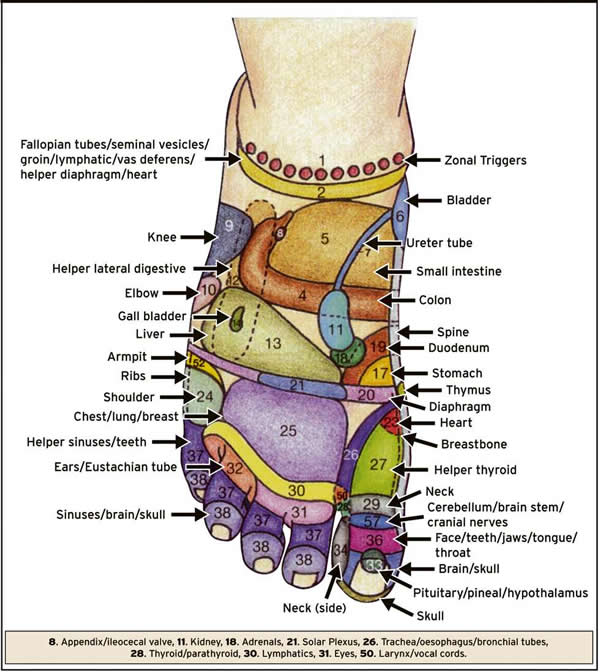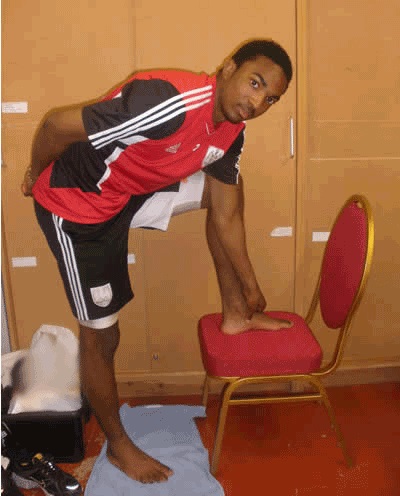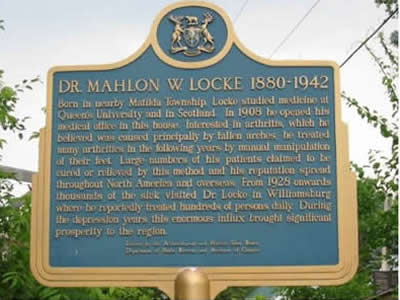Positive Health Online
Your Country

Reflexology: the Feet are an Underestimated Part of the Body
listed in reflexology, originally published in issue 224 - August 2015
Most people take their feet for granted and yet they are a remarkable piece engineering that is essential to support our body from when we are a tiny one year old, who is learning to walk, right through to extreme old age where many have to learn how to pace their steps carefully to keep their balance. This article examines an extraordinary technique, very similar to reflexology, that brought fame and fortune to a Canadian physician in the 1930s, and also highlights areas in therapeutic care of the feet that could benefit everyone including protocols for sportspersons. Reflexologists are trained to understand the construction and mechanisms of the physical foot as well as learning the numerous ‘reflexes’ that form a map of the body on the feet and the hands. Most people associate the feet with reflexology, but the hands also mirror the body and they are easily accessible as a means to help trigger the body to heal itself. These simple techniques offer everyone more control over their health in a gentle and non-invasive way.
Reflexologists precisely stimulate and work the tiny reflex points which together form a mini-map of the body. Reflexes cover the entire hands and feet and every area of the hand or foot relates to a particular part of the body. Working the hands and feet with the aid of reflexology charts is rather like having access to a junction box that just needs tuning and maintaining to help keep the body in a healthy condition. By pressing the tip and base of your thumb, where the head and brain reflexes are situated, you can often help get rid of a headache. Anyone feeling nervous before an interview or exam can now discreetly press an adrenal reflex on their palm below the thumb. Reflexology aims to bring about balance or homeostasis to the body, so if the adrenal glands are excreting too much adrenalin then the aim is to reduce the outflow of adrenalin. Conversely if you felt lethargic, the same points can be worked to stimulate and revitalize a tired body.

Fig 1 Reflexology Map of the Foot
A Reflexology Session can also Bring about Physical Enhancements for the Feet
An interesting secondary aspect has emerged from the application of foot reflexology. Many team players, athletes, tennis players and joggers have reported that their feet feel physically better because they have had a very precise form of stimulation and massage to their feet via reflexology. I work with a professional Championship football team; many players appreciate the fact that feet feel more supple and toned following reflexology and more flexible within their boots. This fact is equally pertinent for all persons, as our feet and hands are the key to our mobility. I feel much more attention should be paid to the maintenance of the feet themselves, and this should include flexing exercises, more chiropody and the use of orthotics when appropriate, as well as reflexology. The feet and ankles should be given greater attention and priority for optimum performance as, without their strength and support, the body cannot properly function. Professional athletes will spend hours in training and receive physiotherapy, massage and many other essential and powerful therapies to bring them to optimum performance and health. But how much specialist intervention and support has been applied to the feet themselves within these protocols? Precise massage and stimulation of the reflexes in the feet can offer an athlete that possible extra 1% in performance which makes the difference between winning and losing. Reflexology is a powerful and therapeutic complementary therapy that supports allopathic interventions.

Fig 2 Self-help on spinal reflexes before a football match
Anatomical Foot Facts
Each food comprises 26 bones and 1/4 of the bones in the human body are in the feet; There are 33 joints; over 100 muscles, tendons and ligaments .Tendons are fibrous tissues that connect muscles to bones and ligaments are fibrous tissues that connect bones to other bones. There is also a network of blood vessels, nerves, skin, and soft tissue. All these components combine and work in unison to provide the body with mobility, support and balance.
Reflexology’s Origins
Reflexology is an ancient healing science whose origins go back 5000 years to China and Egypt. These techniques have also been used by the Native American Indians and the Mayan culture of South America fifteen hundred years ago. Forms of reflexology reached Europe in the Dark Ages after Marco Polo opened up the Silk Routes in the 13th century and were used both by the aristocracy and peasants as a pressure point therapy on the hands and feet. By the late 19th century Zone Therapy and other forms of reflexology were used only by the medical profession until the 1930s in the USA when a physiotherapist called Eunice Ingham developed the zone and pressure point therapy as we know it today. She renamed these revised techniques Reflexology; it is now taught world-wide and practised in hospitals, hospices, clinics and doctors' surgeries as well as in private practice and complementary health centres. It is also used extensively by non-professionals who have learnt the rudiments of reflexology which they successfully offer to family and friends.
![]()
In reflexology terms each foot or hand represents half the body; for example, the head, brain and neck reflexes are situated on the toes and the pelvic reflexes are situated around the ball of the ankle and the spinal reflexes follow the first metatarsal bone down the inside of the foot. The liver reflex is only on the right hand of foot but the kidney reflexes are found on both hands and feet as we have two kidneys. Although reflexes on the feet can be sensitive and may indicate an imbalance in a particular part of the body, it is also important that the reflexologist ensures they do not confuse a tender physical point on the foot, due to a knock or injury, with a sensitive reflex lung point on the ball of the foot, for example, which may indicate to the therapist that there is slight congestion on the lungs following a cough.
A reflexology session is usually 45-60 minutes in length, although often 20-30 minute sessions are offered in nursing homes, to children, in palliative care situations and with some forms of sports injury, especially if a reflexologist is working with sports teams, for example. Many clients apologise for their feet the first time they attend a reflexology appointment as they feel they have neglected them over the years. It is true that the many people who take a pride in their overall appearance may not be too worried by rough, flaky skin, thickened toe nails, small corns, calluses or even an untreated verruca. It is not uncommon for many people to ignore a fungal infection such as Athletes Foot and, only when they are wakened at night by the acute itching sensation, do they decide to consult a chemist or doctor.
Vertical Reflex Therapy (VRT) is a unique form of reflexology that I developed at the St Monica Trust, Bristol in the mid-1990s that allows us to treat our own, and other people's bodies, through their weight-bearing hands and feet in a very different, quick and positive way.[1] The VRT techniques are usually applied to the standing feet, or weight-bearing hands, for a few minutes at the beginning and end of a conventional session so may be incorporated into every reflexology appointment.[2,3]
Reflexology in Brief
- Reflexologists do not prescribe, diagnose or treat specific conditions, but aim to stimulate the body’s own healing response;
- Reflexologists are trained to work various combinations of reflexes to support certain conditions;
- Reflexology and VRT can be used on their own, with other therapies or alongside mainstream medical care to complement allopathic medicine;
- Reflexology is for healthy as well as sick people and has a positive application for all ages.
To conclude, I will examine the curious case of Dr Mahlon William Locke, a Canadian medical physician who, in the 1930s, caused a national sensation when his discovery of a one-minute foot manipulation / pressure technique reached the national press. It was possibly very similar to reflexology and his skills appeared to have cured thousands of people of arthritic and other ailments.[4] After postgraduate studies in Scotland, Locke set up a medical practice in Williamsburg, Ontario and rang a conventional surgery for 20 years during which time he experimented with forms of foot manipulation to ease arthritis and other chronic conditions. His new ‘treatment’ soon took precedent over his medical work as his thousands of patients reported incredible medical results. He would literally spend under a minute on each person and would take their bare foot, twist the toes and manipulate the metatarsal bones by thrusting his hand on the plantar (sole) of the foot. He was known as the “toe-twister”; Locke achieved greater national fame when he successfully treated a renowned novelist Rex Ellington Beach, who wrote about him in a 1932 issue of Cosmopolitan magazine.

Fig 4 Memorial plaque to Dr Mahlon W Locke in Williamsburg, Ontario
His burgeoning reputation caused an overwhelming demand on his services and the little town of Williamsburg was soon overflowing with boarding houses to accommodate the thousands who flocked to see him. There is some original film of Locke’s mode of working.[5] He would sit, usually in the open air on a swivel with lines of patients surrounding him and he would rotate from one person to another, sometimes treating 1,000 patients or more daily. He never charged more than one dollar for his treatments and only 25 cents or free if they could not afford more. Well known personalities endorsed his work. Fellow doctors were intrigued and sceptical in equal measure and many tried to replicate his swift and mechanical foot technique. He died in 1942 and, despite trying to teach his technique to his family and others, this extraordinary skill died with him.
Reflexology aims to relax, balance the body and stimulate the immune system so it functions to its optimum ability. Some research gives support to that theory. Dr Carol Samuel in 2010, completed her PhD at the University of Portsmouth on The scientific evaluation of reflexology for managing pain.[6] Her research results showed that reflexology increases pain threshold (the time at which you first feel pain) and significantly increases pain tolerance (your ability to withstand pain). Dr Ivor Ebenezer, co-author of the study, said: “We are pleased with these results. Although this is a small study, we hope it will be the basis for future research into the use of reflexology”.
The feet are remarkable in their complexity as they not only physically support the body, but also enable a reflexologist to activate the body’s own healing response through stimulation of the reflexes. Reflexologists who learn of Dr Mahlon Locke’s extraordinary discovery often speculate that, as reflexology is an ancient but evolving natural science, perhaps someone will one day rediscover his techniques from a reflexology perspective. Then we may, once again, access the means to achieve another phenomenal healing response from the body.
Reflexology Mobilisation Case Study
Client: Male 56 years, politician.
Condition: Inflammation of right shoulder.
Duration of illness: 4 weeks.
The client presented with a very painful shoulder which he could hardly move. It took a while before he could take off his jacket, with help, and was seated in a chair. He was exhausted through lack of lack of sleep. His shoulder ache had at the end of a very stressful period when he was working more than 12 hours a day. He left for a holiday but was in so much pain that a doctor prescribed anti-inflammatory medication and, when the drugs did not seem to help him much, he took to drinking several glasses of Spanish wine to gain extra sleep. He had his first reflexology treatment on his return; his neck reflexes reflected tension and sensitivity as his entire shoulder area was painful.
Classical reclining reflexology was applied and the weight-bearing VRT techniques were applied to the adrenal and diaphragm reflexes to try and relax him and relieve his pain. He reported that he felt it was working and came twice a week, becoming more energetic again and was elated to show the progress every time. From the second treatment VRT was applied to the following foot reflexes his whole spine (lower lumbar reflexes were tender to touch), cervicals, neck area, brachial tunnel (nerve to shoulder joint), shoulder area, axillary nerve, diaphragm and adrenals. Within 6 visits he nearly could mobilize every movement with his right arm without pain. He continued to receive reflexology once a month for maintenance and relaxation.
Hedwige Dirkx, Reflexologist, Belgium
References
1. Monica Trust: residential care facility. Bristol www.stmonicatrust.org.uk
2. Booth, Lynne. Vertical Reflexology. Publ Piatkus Books, London. ISBN: 0-7499-2132-3 2000.
3. Booth, Lynne. Vertical Reflexology for Hands. Publ Piatkus Books, London.
ISBN: 0-7499-2319-9 2003.
4. The Story of the “Toe-Twister” by George Burden. Mon Jan 3 2011. www.Lifeasahuman.com
5. Screen Culture, The Story of a Country Doctor. Canadian Educational Sponsored and Industrial Film archive. Film: 14 minute duration. www.screenculture.org 1934.
6. Dr Carol Samuel. University of Portsmouth PhD: The scientific evaluation of reflexology for managing pain. carol@reflexmaster.co.uk 2012.
Comments:
-
No Article Comments available